Lamb Glossary: Terms & DefinitionsCooking Lamb? You May Know Lamb Chops, But Here’s Where You Can Get A Leg Up On The Rest Of The Lamb! Skip the overview and to go straight to the glossary. OverviewAmericans don’t eat enough lamb. According to the USDA Economic Research Service, each American eats just 0.8 pound of lamb per year—the equivalent of only two servings. Yet those who love lamb prefer it to other red meats. Lamb is also the oldest meat animal raised by man. Domestication began about 9,000 years ago in the Middle East. There, and in many countries—Australia, Greece, New Zealand, the U.K. and Patagonia, for example—lamb is the primary source of meat and is also valued for its wool. The Brits are fond of roast lamb with mint sauce, thanks to the Romans who introduced sheep to the island more than 2,000 years ago. Lamb came to the Western Hemisphere in the second century of the 1500s, with the Spanish conquistadors, led by Hernàn Cortez. (The Spanish brought lamb and honeybees and took back cacao, chiles, corn, potatoes and tomatoes, among other things.) |
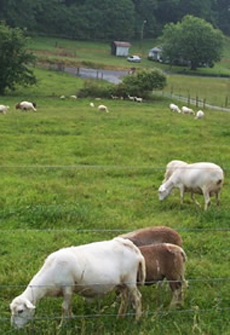 Heirloom Katahdin lamb. Photo courtesy Clover Creek Farms. |
|||
Lamb:It’s Not Just A Spring Dish While the term “spring lamb” leads some people to think of lamb as a seasonal food, it is now available year round (see the definition of spring lamb). Click on the letter of the alphabet in this bar to get to a term without having to scroll manually: a b c d e f g h i j k l m n o p q r s t u v w x y z This glossary is protected by copyright and cannot be reproduced in whole or in part. You are welcome to link to it.
|
||||
AGED LAMB Lamb is aged to develop additional tenderness and flavor. Usually only ribs and loins of high-quality lamb are aged, and these products are mainly sold to restaurants. Aging is done commercially under controlled temperatures and humidity, for 10 days to 6 weeks. |
||||
BABY LAMB Lamb that is slaughtered when it is between six and eight weeks old. |
||||
BONED, ROLLED & TIED (BRT) A leg or shoulder roast that is completely boned, with the internal fat removed and the excessive outer fat trimmed off. Properly rolled, it will be cylindrical in shape and ideal for a rotisserie or as an oven roast. You can see a photo of a boneless shoulder cut roast below in the Shoulder Cuts chart. |
||||
BOTTOM ROAST A boneless roast cut from the leg. |
||||
BREAST CUTS The breast of the lamb yields the following cuts: breast and rolled breast, which are roasted (baked) or braised; the stuffed breast, which is roasted; riblets and boneless riblets, which are braised; spareribs, which are braised or roasted; and stuffed chops, which are broiled, panbroiled or panfried. See the different cuts in the chart at the right. BUTTERFLIED LEG OF LAMBThe leg, completely boned and removed of all excess fat. When spread flat on the cooking surface, it resembles a butterfly. Popular for broiling or outdoor grilling, it provides a natural range of “doneness,” since the thickest portion will be rare, the middle medium and the thinnest portions well done. |
 Chart of foreshank and breast cuts courtesy of American Lamb Board. |
|||
CHUMPA term used in U.K. countries for the top sirloin. COOKING TIME ~ LAMB ROASTDepending on the size of the roast, whether it is leg, rib or shoulder, and whether you want the meat rare, medium or well done, estimate 15 to 40 minutes per pound at 324°F. Download a lamb cooking guide for details. A meat thermometer will register 145°F for rare, 160°F for medium and 170°F for well-done. Cover to keep warm and allow the roast to stand for 15 minutes before serving so the juices will settle. Remember that during this time the temperature will continue to rise 5 to 10 degrees, so remove the lamb before the temperature reaches the desired degree of doneness.
|
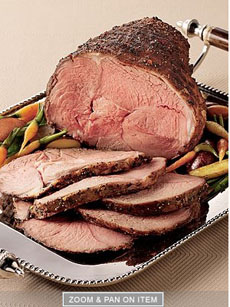 A roast leg of lamb. Photo courtesy Allen Bros. |
|||
CROWN ROAST OF LAMB or LAMB CROWN ROAST or INTERLACED ROAST The crown roast is perhaps the most impressive piece of lamb one can prepare. It is made by curving around two rib halves, of eight ribs each (the racks of lamb), and tying them to form a circle, or “crown.” See a photo in the chart of Rib Cuts. The frilly white papers placed on the ends of the legs are called “panties.” CUTLET A cutlet is a thin, boneless chop, or one with a piece of rib bone in the center.
|
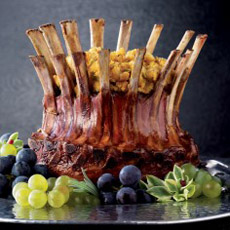 A crown roastof lamb. Photo courtesy Allen Bros. |
|||
CUTSThere are five basic major (primal) cuts of lamb: leg, loin, shoulder, rack and shank/breast.* Food markets further label the product directionally, e.g., “shoulder roast,” “boneless breast” and “loin chop.” |
||||
DENVER RIBS Lamb spareribs cut from the breast and trimmed of all fat and connective tissue. DOUBLE-CUT CHOPS Chops that include two ribs instead of one (single-cut chops). EWE An adult female sheep. The male is a ram. FELL The fell is the paper-thin covering of outer fat on a roast. It is usually removed for small cuts, like chops, but should be kept in place for roasts and legs because it helps retain the shape and juiciness when cooking.
|
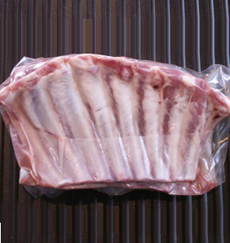 Denver ribs. Photo courtesy AgriculturalConnections.com. |
|||
FOREQUARTER The forequarter includes the neck, shoulder, front legs foreshank/breast and ribs. FRENCHED When a piece of meat is Frenched, 1-1/2 inches of meat is removed from the bone ends of a rib roast or rib chops to create an elegant presentation. Elegance is just one reason to ask the butcher for Frenched chops. Since there is little meat on the bone and much fat, there is less fat to cut away on the plate and less fat in the pan to clean up.
|
 Frenched lamb chops. Photo courtesy Blu Restaurant | New York City. |
|||
FRENCH SEARINGA method that produces an excellent roast, although it results in more shrinkage, oven splattering, and sometimes smoke and excessive cooking odors. Preheat the oven to 450°F and roast for 15 to 20 minutes to brown, then reduce heat to 325°F and continue roasting to the desired degree of internal doneness (see Cooking Time, above). |
||||
GRADES OF LAMB Grading of lamb is voluntary, and plants pay to have meat graded. USDA-graded lamb sold at the retail level include Prime, Choice and Select. Lower grades (Utility and Cull) are mainly ground or used in processed meat products like sausage. Grade, maturity, color, firmness and texture of the lean are evaluated in terms of their relationship to the ultimate flavor and tenderness of the meat. USDA Prime lamb has more fat marbling, so it is the most tender and flavorful grade. However, more marbling means that it is higher in fat content. Most of the graded lamb sold in supermarkets is USDA Choice or USDA Select, with the USDA Prime bought up by fine butcher shops and restaurants (and Prime represents the smallest percentage of graded meat in the first place).
|
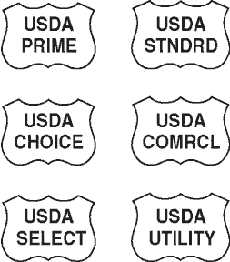 USDA classifications of meat from left row, top down, to right row, top down. |
|||
|
The protein, vitamin and mineral content of lamb are similar in all grades. Ungraded lamb does not indicate that the lamb is either higher or lower in quality than graded lamb, and all lamb sold in the U.S. has been government inspected for wholesomeness (i.e., it is disease-free). |
FRENCH SEARINGA method that produces an excellent roast, although it results in more shrinkage, oven splattering, and sometimes smoke and excessive cooking odors. Preheat the oven to 450°F and roast for 15 to 20 minutes to brown, then reduce heat to 325°F and continue roasting to the desired degree of internal doneness (see Cooking Time, above). |
|||
GROUND or CUBED LAMBGround or cubed lamb made be made from any cut. Cubes are used for stew; cubed steaks and lamb patties can be broiled or panfried; ground lamb can be cooked in any variety of ways, from burgers to moussaka and in other famous (and not-so-famous) dishes. See the different cuts in the chart at the right.
|
 |
|||
HORMONES, ANTIBIOTICS & ADDITIVESHormones. Zeronal, a synthetic hormone, may be used to promote efficient growth in feedlot lambs (the feedlot stage is the final stage before slaughter). The hormone is implanted on the lamb’s ear and is time-released for about 30 days. A withholding period when no hormones are given is required for at least 40 days before slaughter. Antibiotics. Antibiotics may be given to prevent or treat disease in lambs. A recommended withholding period is required from the time antibiotics are administered until it is legal to slaughter the animal, so residues can exit the animal’s system. Random samples from the Food and Drug Administration’s monitoring program have shown a very low percentage of residue violations. (Choice-grade lamb is available at retail that is raised without antibiotics and growth hormones.) Additives. Additives such as MSG, salt or sodium erythorbate are not allowed to be used on fresh lamb. If they are used on processed lamb, they must be listed on the label. | ||||
INTERLACED ROAST LAMBThe meat of a sheep that is less than one year old. Meat from an older sheep is called mutton. Most lambs are brought to market when they are between six and eight months. Typically, lambs graze on pasture and different types of grain and are “finished” (grown to maturity) in feedlots, where they receive specially-formulated feed. A mature lamb weighs about 120 pounds and yields approximately 42 pounds of saleable meat. LAMB CHOPLamb chops are cut from the shoulder, rib, loin and sirloin area. Loin chops and rib chops are the most tender. The less expensive shoulder chops (called blade and arm chops) and sirloin chops from the leg can be just as tender, but they are not as visually attractive because the meat is separated by bands of connective tissue. Chops are usually served broiled, panfried or grilled. LAMB STEAKLamb steaks are cut from the leg. They are a way to enjoy “leg of lamb” when there aren’t enough people to eat a leg. They can be marinated and then raised, broiled, grilled or sautéed. They are easy to pan-fry pan in olive oil, seasoned with thyme, 2 minutes a side. Sprinkle salt and pepper after cooking; deglaze the pan with white wine and more herbs. LEG CUTSThe leg of lamb produces a leg center slice (steak) for broiling, grilling, panbroiling or panfrying and a variety of of roasts: American-style leg, boneless leg (rolled), center leg, combination leg, French-style leg, French-style leg/sirloin off, shank half of leg and sirloin half of leg. See the different cuts in the chart at the right. LEG OF LAMBThe leg of lamb can be the whole leg including the sirloin, or the short cut leg, sirloin of. It is usually roasted, though it can be broiled, grilled and barbecued as well. Some find the rear of the lamb has bolder flavor, but retains the same juicy tenderness as the rib and loin portions. |
 Chart of lamb cuts in black boxes are courtesy of American Lamb Board. |
|||
LOIN CUTSThe loin comprises the ribs between the forequarter (see definition above) and hindquarter (sirloin and leg). Loin cuts include loin cuts and boneless double loin chops for broiling, panbroiling and panfrying; the loin roast and the boneless double loin roast. See the different cuts in the chart at the right. MILK-FED LAMBThe meat from an unweaned lamb four to six weeks old. It is largely unavailable in the U.S. but more common in northern Spain. Milk-fed lamb meat is considered finer than older lamb. See also Baby Lamb. |
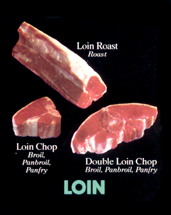 Charts of leg and loin cuts courtesy of American Lamb Board. |
|||
MUTTONThe meat of a sheep older than one year. Mutton is often less tender than lamb, with a stronger flavor. In many eastern countries such as India and Pakistan, mutton refers to goat meat, not sheep meat. NATURALProducts labeled “natural” cannot contain any artificial flavoring, coloring, chemical preservative or other artificial or synthetic ingredient. The product and its ingredients cannot be more than minimally processed (ground meat, for example). All products claiming to be natural should be accompanied by a brief statement which explains what is meant by the term “natural.” |
||||
NOISETTE A noisette is a boned loin roat. It is often stuffed, then rolled: a succulent, tender loin and beautiful presentation that is popular for easy entertaining.
|
 Noisette of lamb. Photo courtesy H.G. Walter. |
|||
NUTRITION Lamb is a nutrition-dense food. A four-ounce serving of roast lamb has 220 calories and provides 60.3% of the daily value for protein and 21.1% of the DV for fat. It is an excellent source of selenium, tryptophan, vitamins B12 and B3 (niacin), and a good source of phosphorus and zinc. OFFAL See variety meats. OVEN-READY LEG The hipbone has been removed from the leg and the leg has been netted or tied, ready to season and roast.
|
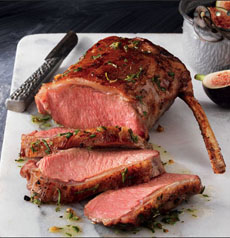 Loin lamb chops. Photo courtesy AllenBros. |
|||
PRE-SLICED & TIED SHOULDER The square-cut shoulder contains four or five ribs. Two one-inch-thick, round bone chops are removed. The shoulder is then sliced (blade bone side) into three-quarter-inch chops, put together and tied with two strings. You can see a photo in the chart of Shoulder Cuts. |
||||
PROCESSED LAMB Lamb that has been transformed from its raw state by grinding, chopping, cooking and/or the addition of spices and seasonings. Examples include lamb sausage and lamburgers. RACK OF LAMB or RIB ROAST The rack is the unsplit rib (sometimes called the hotel rack) of the carcass, which includes ribs 6 through 12 and the thick, meaty rib-eye muscle (the meat). The rack is split to make two lamb rib roasts. A “crown roast” is made by sewing two rib roasts together to form a circle or crown.
|
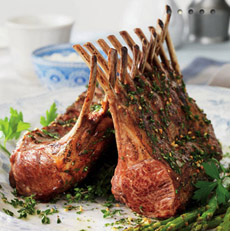 Rack of lamb. Photo courtesy AllenBros. |
|||
RAMAn adult male sheep. RED MEATOxygen is delivered to muscles by the red blood cells. One of the proteins in meat, myoglobin, holds the oxygen in the muscle. The amount of myoglobin in animal muscles determines the color of meat. Lamb is red because it contains more myoglobin than chicken or fish. The other red meats are beef, pork and veal. |
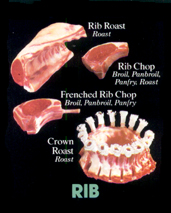 |
|||
RIB CUTSThe rib area lies between the shoulder and the loin. Cuts include rib chops and Frenched rib chops, which are broiled, grilled, panbroiled or panfried; the rack of lamb (or rib roast) and the crown roast. RIB ROASTSee rack of lamb. SADDLE OF LAMBThis large cut from the loin section comprises the foresaddle (the front of the lamb up to the 12th rib), the hindsaddle (the rear half of the lamb from the 13th rib, back) plus the hip. The saddle is usually boned and often stuffed prior to roasting.
|
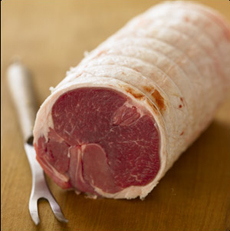 Saddle of lamb. Photo courtesy H.G.Walter. |
|||
SARATOGA ROLL OR CHUCK EYEA boneless center roast in the blade portion of the shoulder. SHEEPSheep are currently the most abundant livestock in the world. They were originally domesticated in the Middle East and Asia more than 9,000 years ago. Sheep husbandry is practiced throughout the inhabited world. There are more than 200 breeds, which are selected based on their suitability to meat, milk, wool, hides or a combination. Sheep are often thought of as stupid animals. In fact, they are on a par with cattle in IQ, and just below pigs.
|
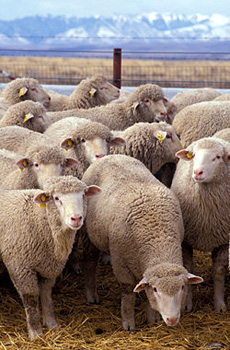 A flock of ewes. Photo courtesy of Wikipedia. |
|||
SHOULDER CUTSThe shoulder of the lamb is less expensive than the rib, loin or leg. While the meat is well-marbled and full-flavored, there is more connective tissue. The shoulder yields the following cuts: cubes for kabobs; blade chips, boneless blade chops (Saratoga chops) and arm chops, which can be broiled, panbroiled and panfried; and the boneless shoulder, cushion shoulder and square shoulder roasts. There is also meat for stewing. See the cuts in the chart at the right. Sirloin CUTS |
 Chart of shoulder cuts courtesy of American Lamb Board. |
|||
SPRING LAMBA lamb processed between the first Monday in March and the first Monday in October. It is usually 3 to 5 months old. Years ago, lamb production peaked during this season, because lambs born in harsh winter months would have a low chance of survival. With modern animal husbandry conditions, lamb production occurs throughout the year, and “spring lamb” is no longer a relevant term, except for marketing purposes.
|
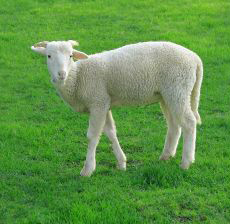 A spring lamb in a verdant summer pasture. Photo by Nevit Dilmen | SXC. |
|||
USDA-INSPECTEDAll lamb found in retail stores undergoes mandatory government inspection, either by USDA inspectors or by state systems which have standards equal to the Federal government. Each lamb and its internal organs are inspected for signs of disease. Product dating is not required by Federal regulations. This is done voluntarily by stores and processors. VARIETY MEATS OR OFFALThe lamb’s brains, heart, kidney, liver and tongue.
|
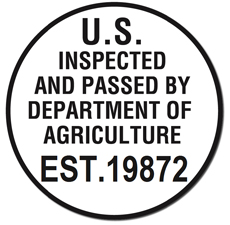 A spring lamb in a verdant summer pasture. Photo by Nevit Dilmen | SXC. |
|||
WINE PAIRINGS Try the following wine pairings with lamb: YEARLINGA lamb between one and two years old. SOURCES:
|
 A yearling. Photo by BN | SXC. |
|||
Last Updated Mar 2021
© Copyright 2005-2025 Lifestyle Direct, Inc. All rights reserved. All images are copyrighted to their respective owners.
